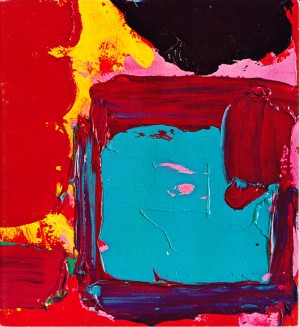‘John Hoyland: Paintings 1967-1979’ by Bryan Robertson
Essay accompanying Hoyland’s first full-scale retrospective, at the Serpentine.
It is [the] element of surprise in Hoyland’s painting which delights me more than anything else, and I am not suspicious of my motives in searching it out and enjoying the spectacle. Painting as charged and brilliant as Hoyland’s stands or falls on its own merit, without the alibi of a figurative basis or rationale. My own perception is shared by others: from the beginning, Hoyland seems to have willed abstraction beyond its usual limits so that the formal means taken, through colour and brushwork, to arrive at a particular end, embark upon their own celebration and extravagances of colour and varied impasto – through intensity of physical expression and a willingness to aim, nearly always, at the unfolding of a spectacle rather than the mere trapping of a formal idea. […]
The dominant characteristic in Hoyland’s best painting is its vitality: a super-charged expression of physical well-being, painted with an almost reckless generosity of scale and manner. The mood of this expressive power is almost invariably warm and positive: there are very few melancholic or grim paintings by Hoyland. And it is this pitch of vitality which makes ‘the process of development invisible in the synthesis of the completed work’, because of the transparent belief, so strongly communicated in each work – however involuntarily – in the validity of painting as a unique means of saying something – however obliquely – about the human spirit in relation to the exterior physical world, or the circumstances of living, of inhabiting and reacting to a context.
Hoyland’s paintings are not truly abstract expressionist in concept or manner, apart from their large scale. They are too obviously concerned with variations on thematic treatment of shapes tightly related to format – to vertical or horizontal canvases, and making simple shapes ‘work’ in radical ways to achieve an unexpected forcefulness within these conventional formats. Hoyland is not concerned with self-exploration in terms of psychic or abstract automatism, but he is intent upon refurbishing and extending the possibilities of basic pictorial principles. But if this initial impulse in pictorial composition seems cerebral, his sensuous enjoyment of pigment, colour, and the exploration of the absolute extremities of an abstractly pictorial situation tend toward a pictorial grandeur and excitement which approximate to the more directly sensuous examples of abstract expressionism.
© Bryan Robertson / Arts Council of Great Britain, 1979
